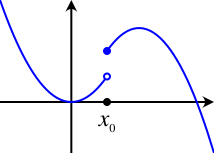A-level Mathematics/OCR/C3/Algebraic Functions
Functions
Notation
Here is the notation that is used when dealing with mapping questions.
means a set of ...
E.g. means a set of where is bigger than or equal to 2.
means the function f maps the set X is mapped into the set Y. Another way to write this is .
- Natural Numbers – e.g. {1,2,3,. ..}
- Integers – e.g. {...−2,−1,0,1,2,. ..}
- Fractions (of rational numbers)
- Real Numbers, including rational and irrational numbers but not complex numbers such as
Irrational numbers have no general symbol – their notation is specific - e.g. {}
Definitions
Mapping: a rule connecting two sets of items.
Object/Input: an item in the starting set.
Image/Output: an item in the finishing set.
Domain: the set of all objects.
Co-domain: set of all possible finishing values.
Range: elements from the co-domain that are actually used.
Different Mappings
1) unique unique (1:1 or injective mapping)
2) several unique (many:one mapping)
3) unique several (one:many mapping)
4) several several (many:many mapping)
NB: A function can only be a 1:1 (injective) or many:one mapping.
Basic Properties
A function relates each of its inputs to exactly one output. If there are ever two outputs the formula it is not a function. For example is a function because every x has only one output, but is not a function because every x can have two values, for example 4 = and so x can be 2 or -2. Graphs of circles (and similar shapes) represent many:many mappings and so they are not functions. You can determine if a graph is a function by using the vertical line test. This test states that a graph is a function if and only if any vertical line drawn will intersect the graph only once. There are four ways to represent a function:
1)A Formula
2)A Graph
3)A Table
4)Verbally
Domain and Range
Every function has a domain and range. The domain is the set of the input values. The range is the set of the output values. Remember if there is a reflection or translation in the function, there will be a reflection or translation in either one or both the domain and range. In example:
The domain of is and the range is but the domain of is and the range is . See [[../../C1/Coordinate Geometry and Graphs#Stretching|Reflection Rule 1 and Translation Rule 2]].
Domain
The domain of a function is generally all with these three notable exceptions: 1) If x is in the denominator, the point at which the denominator is zero is not in the domain, E.g
the domain will be all except for 1.
2) If the exponent is less than zero and an even quantity, the domain will be , E.g
the domain will be but will be all .
3) In a piecewise function the domain will be restricted by the definition, E.g
The domain of will be (5,10).
Range
There is one simple rule to remember for range. All even functions have a range of and odd functions have a range of all .
Piecewise Functions

A piecewise function is a function that is given by different expressions on different intervals. The graph of
is shown on the right. The open circle indicates that the point is not included on the graph and the closed circle indicates that the point is included on the graph. So
= 8 not 4.
One-One Function
A one-one function must have a unique output for every input. In example will not be one-one because the inputs -2 and 2 will both produce the output 4, but will be one-one because every input will produce a unique output, f(-2)= -8 and f(2)=8. You can determine if a graph is one-one by using the horizontal line test. This test states that a function is one-one if and only if any horizontal line drawn will intersect the graph only once.
Inverse Function
The inverse of the function will produce the input value for the output value of the function. A function must be one-one in order for the inverse of the function to exist. To illustrate this mathematically: and . Also the composition of the inverse and the function will produce x: . An illustration involving apples and lemons can be found below. The original functions turns apples into lemons and the inverse function turns lemons into apples.
To find the inverse of a function.
1)Solve the equation in terms of x
2)Switch y with x.
3)Write in the notation
In Example find the inverse of .
1)

2)
3)
You can test this out now and .
Graphical Representation of One-One Functions
When we graph an inverse of a one-one function we simply have to switch the x and y co-ordinates:(x,y) becomes (y,x). The co-ordinate (5,7) will be (7,5) on the inverse graph. The graph will be a reflection through the line y=x. In the example on the right the red line is the graph of and the green line is the graph of .
Composition of Functions
The mathematical symbol for composition of a function is . Alternatively a composition can be written as When you compose two functions you replace all instances of the variable with the second function. You can tell the order of the function by the order that the composition is written in , means F is composed of G. If the domain or range is restricted in some way in the original function it will be restricted in the same way in the composite function.In example and find . Then find the domain and range
1) Replace all instances of x in f with giving .
2) Now simplify. .
3) The domain will be because g(x) can never have a negative x value, and the range will be because g(x) can never be negative.